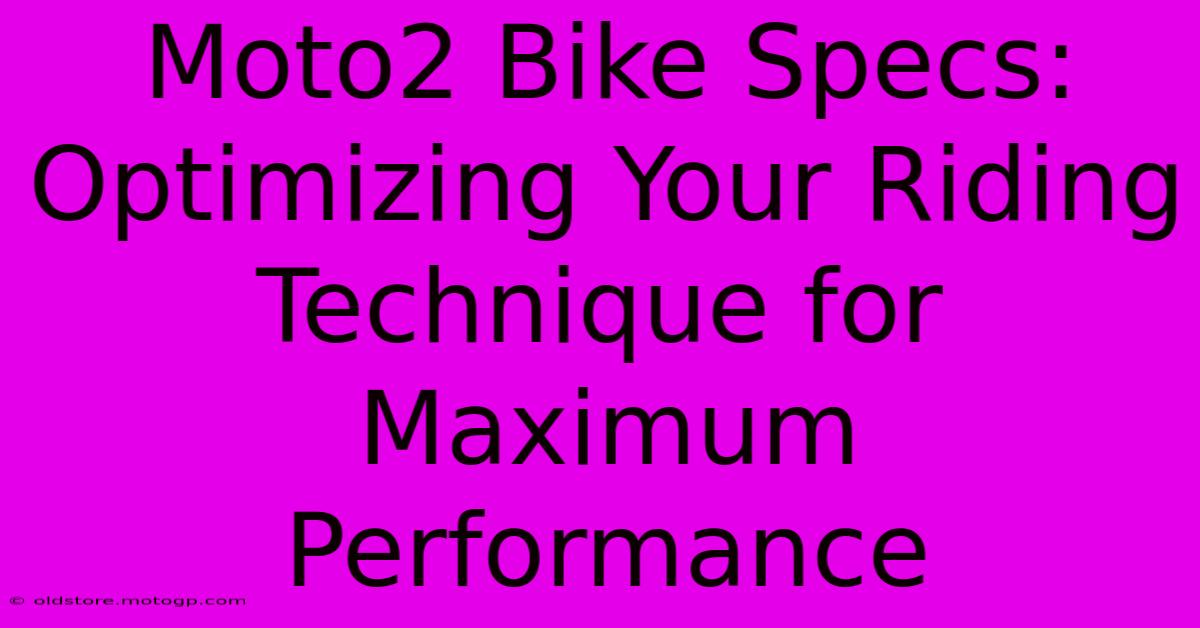Moto2 Bike Specs: Optimizing Your Riding Technique For Maximum Performance

Table of Contents
Moto2 Bike Specs: Optimizing Your Riding Technique for Maximum Performance
The Moto2 class represents the pinnacle of intermediate-level motorcycle racing. These bikes, with their meticulously engineered specifications and powerful engines, demand a high level of skill and precision from their riders. Understanding the key specs and how they influence riding technique is crucial for maximizing performance. This article delves into the intricacies of Moto2 bike specifications and explores how riders can optimize their technique to fully exploit the machine's potential.
Key Moto2 Bike Specifications: A Technical Overview
Moto2 bikes are standardized to ensure a level playing field, focusing competition on rider skill. This standardization centers around the engine: a Triumph 765cc inline-triple. Let's explore some key specifications influencing riding technique:
Engine: The Heart of the Beast
- 765cc Inline-Triple Engine: This engine delivers impressive power and torque, but its characteristics demand a specific riding style. The triple's smooth power delivery, compared to a four-cylinder, requires a different approach to throttle control, particularly exiting corners. Riders need precise throttle modulation to prevent wheelspin and maintain traction.
- Power Output: While exact figures aren't publicly released, the power output is substantial, requiring riders to manage the bike's immense acceleration effectively. This necessitates strong braking techniques and precise gear selection to maximize exit speed.
- Torque Curve: The torque curve plays a significant role in cornering. Understanding the engine's power band allows riders to select the optimal gear for each corner, maximizing acceleration out of the apex.
Chassis: The Foundation of Control
- Aluminum Twin-Spar Frame: This lightweight yet rigid frame contributes to precise handling and nimble cornering. Riders need to understand how the chassis responds to different inputs, adapting their body position and steering inputs to maintain optimal control.
- Suspension Setup: The sophisticated suspension, usually featuring Öhlins components, allows for fine-tuning to suit track conditions and rider preference. Mastering the setup and adapting it to varying circumstances is critical for consistent lap times.
- Braking System: Powerful Brembo brakes are a standard feature. Efficient braking is paramount, requiring strong braking technique and precise lever control to avoid lockups and maximize braking performance.
Electronics: Aiding Rider Performance
- ECU (Engine Control Unit): The sophisticated ECU manages engine parameters, providing features like traction control and wheelie control. Understanding how these systems interact with rider inputs is crucial for optimizing performance.
- Data Acquisition: Extensive data acquisition systems provide detailed information on various aspects of riding performance. Analyzing this data allows riders to identify areas for improvement and refine their technique.
Optimizing Riding Technique: Harnessing the Moto2 Beast
Understanding the Moto2 bike specs is only half the battle. Optimizing riding technique requires a holistic approach focusing on several key aspects:
Corner Entry: Precision and Smoothness
Smoothness is key. Aggressive braking should be avoided in favor of controlled deceleration, allowing for precise line selection and smooth turn-in. Proper body positioning and weight transfer are crucial for maintaining stability.
Apex: Maximizing Momentum
Finding the optimal apex requires precise throttle control and understanding the bike's characteristics. Maintaining momentum through the apex is crucial for strong exit speed.
Corner Exit: Power and Control
This phase requires precise throttle control to manage the power output effectively, avoiding wheelspin and maximizing acceleration. Understanding the engine's power band and using the correct gear is crucial for optimal exit speed.
Overall Riding Style: Adaptability and Consistency
Moto2 racing demands a high degree of adaptability. Riders must adjust their riding style to suit varying track conditions, weather, and tire wear. Consistency is key to achieving optimal lap times and competitive performance.
Conclusion: The Synergy of Machine and Rider
Mastering the Moto2 machine requires a profound understanding of its specifications and a highly refined riding technique. The synergy between rider skill and machine capabilities is paramount for achieving peak performance. By understanding the technical intricacies of the bike and honing their riding technique, Moto2 racers can unlock the true potential of this incredible machine. Continuous learning and adaptation are crucial to remain competitive at the highest level of intermediate-level motorcycle racing.

Thank you for visiting our website wich cover about Moto2 Bike Specs: Optimizing Your Riding Technique For Maximum Performance. We hope the information provided has been useful to you. Feel free to contact us if you have any questions or need further assistance. See you next time and dont miss to bookmark.
Featured Posts
-
Moto Gp Arcade Race To The Finish Line
Feb 20, 2025
-
Moto Gp Pictures For True Enthusiasts
Feb 20, 2025
-
Lot F Cota Unleashing Your Potential
Feb 20, 2025
-
The Impact Of Sprint Races On Moto Gp Rider Fitness
Feb 20, 2025
-
Sepangs Spectacle Malaysian Motorcycle Grand Prix
Feb 20, 2025
